
| |

| |
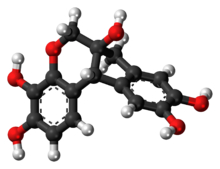
| |
| Names | |
|---|---|
| Preferred IUPAC name
(6aS,11bR)-7,11b-Dihydroindolo[2,1-c] [1]benzopyran-3,4,6a,9,10(6H)-pentol | |
| Other names
Hematoxylin; Natural Black 1; Hematoxyline; Hydroxybrazilin; Hydroxybrasilin; C.I. 75290
| |
| Identifiers | |
3D model (JSmol)
|
|
| ChEMBL | |
| ChemSpider | |
| ECHA InfoCard | 100.007.490 |
| MeSH | Hematoxylin |
PubChem CID
|
|
| UNII | |
CompTox Dashboard (EPA)
|
|
| Properties | |
|---|---|
| C16H14O6 | |
| Molar mass | 302.282 g·mol−1 |
| Melting point | 100-120 °C |
Except where otherwise noted, data are given for materials in their standard state (at 25 °C [77 °F], 100 kPa).
| |
Haematoxylin or hematoxylin (/ˌhiːməˈtɒksɪlɪn/), also called natural black 1 or C.I. 75290, is a compound extracted from heartwood of the logwood tree (Haematoxylum campechianum)[1][2] with a chemical formula of C
16H
14O
6. This naturally derived dye has been used as a histologic stain, as an ink[3][4][5][6] and as a dye in the textile and leather industry.[7][8] As a dye, haematoxylin has been called palo de Campeche,[8] logwood extract,[7] bluewood[9] and blackwood.[9] In histology, haematoxylin staining is commonly followed by counterstaining with eosin.[1][10][11] When paired, this staining procedure is known as H&E staining and is one of the most commonly used combinations in histology.[1][7][12][13][14] In addition to its use in the H&E stain, haematoxylin is also a component of the Papanicolaou stain (or Pap stain) which is widely used in the study of cytology specimens.[1][14]
Although the stain is commonly called haematoxylin, the active colourant is the oxidized form haematein, which forms strongly coloured complexes with certain metal ions (commonly Fe(III) and Al(III) salts).[1][7][8][15][16] In its pure form, haematoxylin is a colourless and crystalline solid,[7][17] although commercial samples are typically light to dark brown based on the level of impurities present.[2][18]
https://en.wikipedia.org/wiki/Haematoxylin
Principally used as a nuclear stain (to stain the cell nucleus), haematoxylin will also stain rough endoplasmic reticulum, ribosomes, collagen, myelin, elastic fibers, and acid mucins.[10] Haematoxylin alone is not an effective stain, but when oxidized to hematein, and combined with a mordant, stains chromatin in cell nuclei dark blue to black.[1][7][25][10] The colour and specificity of haematoxylin stains are controlled by the chemical nature, and amount, of the mordant used, and the pH of the staining solution, thus, a variety of haematoxylin formulations have been developed.[1][10][15]
https://en.wikipedia.org/wiki/Haematoxylin
Stain formulations

Haematoxylin stain formulations can be broadly classified based on how the haematoxylin is oxidized (or ripened) and by choice of the mordant used.[1] Haematoxylin stain formulations may either be natural oxidized by exposure to air and sunlight, or more commonly, especially in commercially prepared solutions,[7] chemically oxidized using sodium iodate.[1][26][11] Commonly only enough oxidizer is added to convert one half of the haematoxylin to haematein, allowing the remainder to naturally oxidize during use, this extends the staining solution's useful life as more haematein is produced, while some haematein is further oxidized to oxyhaematein.[13][27][11] Of the metallic salts used as mordants, aluminium is the most common,[11] other mordants include salts of iron, tungsten, molybdenum and lead.[1]
Depending on the formulation or staining technique, haematoxylin stains may be used in what is called a progressive manner, in which the length of time the tissue remains in contact with the staining solution is used to control the amount of colouration, or in a regressive manner, in which the tissue is over-stained, and excess stain is removed in a secondary step of the procedure.[11][25][1] Removal of unwanted staining, or differentiation, typically involves a solution of diluted ethanol and hydrochloric acid.[11][1][20]
https://en.wikipedia.org/wiki/Haematoxylin
Shortages and possible alternatives
During World War I, the late 1920s, World War II, the early 1970s (summer 1973[22]) and in 2008, there were shortages of haematoxylin due to interruptions in its extraction from logwood.[18] These shortages prompted a search for alternative nuclear stains.[22][18] Several synthetic dyes have been recommended as replacements, notably celestine blue (CI 51050),[18] gallocyanine[7][11] (CI 51030), gallein[18] (CI 45445) and eriochrome cyanine R[18][11] also called chromoxane cyanine R and solochrome cyanine (CI 43820). All four have Fe(III) as the mordant. An alternative is the aluminium complex of oxidized brazilin, which differs from haematoxylin by only one hydroxyl group. A replacement stain for haematoxylin in H&E staining must also not disrupt the ability of histologists and pathologists,[14] who have spent years of training with H&E stained slides, to examine the slides and make medical diagnoses.[7] None of proposed replacement stains have been widely adopted.[14][7]
https://en.wikipedia.org/wiki/Haematoxylin
Early use as a histologic stain
In 1758, Georg Christian Reichel used haemotoxylin, without a mordant, to stain plant tissues.[31][12][32] John Thomas Quekett in an 1852 book,[33] suggests using "logwood" (haematoxylin) to dye translucent material for examination under the microscope.[32][31] In 1863, Wilhelm von Waldeyer-Hartz used haematoxylin on animal tissue without a mordant (with limited success),[34] and is sometimes credited as being the first to do so,[8][12][35][34] although this is not universally accepted.[35][8] Franz Böhmer in 1865 published a haematoxylin formula using alum as a mordant,[34][21][12][8][35][31] and in 1891, Paul Mayer published a formulation using a chemical oxidizer to convert haematoxylin into haematein.[26][31][12] The first use of haematoxylin with eosin as a counterstain, which is currently the most used stain combination in histology, was first suggested by A. Wissowzky in 1876.[15][31] By the early 1900s, haematoxylin had become widely accepted as a histologic stain.[12]
https://en.wikipedia.org/wiki/Haematoxylin

Phosphotungstic acid haematoxylin (PTAH) is a mix of haematoxylin with phosphotungstic acid, used in histology for staining.
It stains some tissue in contrasting colors in a way similar to haematoxylin and eosin stain, as phosphotungstic acid binds to tissue proteins. It is used to show gliosis in the central nervous system, tumours of skeletal muscles, and fibrin deposits in lesions. Muscle is stained blue-black to dark brown, connective tissue is pale orange-pink to brownish red, fibrin and neuroglia stain deep blue, coarse elastic fibers show as purple, and bone and cartilage obtain yellowish to brownish red color.
PTAH is ideal for demonstrating striated muscle fibers and mitochondria, often without a counterstain. As such, it is used to identify contraction bands, as seen in contraction band necrosis.[1]
PTAH stains ependymomas while it does not stain choroid plexus papillomas, providing one means of differentiating these tumors.
This technique has been largely replaced by immunohistochemistry techniques.[2]
https://en.wikipedia.org/wiki/Phosphotungstic_acid-haematoxylin_stain
Use as a textile dye
Haematoxylin was first used as a dye by the Mayans and Aztecs in Central America where logwood trees grow natively.[8][9] The dye was first introduced to Europe by the Spanish, and soon after was widely adopted.[9][8] Haematoxylin was used to produce blacks, blues and purples on various textiles, and remained an important industrial dye until the introduction of suitable replacements in the form of synthetic dyes.[9] As a blue dye (with alum as a mordant), the initial results were not as lightfast as those produced using indigo.[7][9] In reaction to this perceived inferiority of the quality of the blue colour produced with haematoxylin, its use to dye fabric was barred in England from 1581 to 1662.[8][9] After the introduction of synthetic black dyes in the late 19th century, haematoxylin was first replaced as a dye for cotton.[9] A 1902 German treatise on the dyeing textiles notes "...logwood in the black dyeing of cotton has suffered considerably from the competition of aniline black".[36] Haematoxylin remained important as a black dye (using copperas or chrome as a mordant) for wool until the 1920s when a black synthetic dye compatible with wool became available.[9] Contemporary usage of haematoxylin includes the dyeing of silk, leather, and sutures.[7]
https://en.wikipedia.org/wiki/Haematoxylin
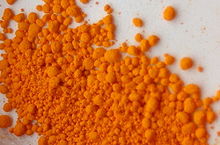
| |

| |
| Names | |
|---|---|
| IUPAC name
Mercury(II) oxide
| |
| Other names | |
| Identifiers | |
3D model (JSmol)
|
|
| ChemSpider | |
| ECHA InfoCard | 100.040.580 |
| KEGG | |
PubChem CID
|
|
| RTECS number |
|
| UNII | |
| UN number | 1641 |
CompTox Dashboard (EPA)
|
|
| Properties | |
|---|---|
| HgO | |
| Molar mass | 216.591 g·mol−1 |
| Appearance | Yellow or red solid |
| Odor | odorless |
| Density | 11.14 g/cm3 |
| Melting point | 500 °C (932 °F; 773 K) (decomposes) |
| 0.0053 g/100 mL (25 °C) 0.0395 g/100 mL (100 °C) | |
| Solubility | insoluble in alcohol, ether, acetone, ammonia |
| Band gap | 2.2 eV[1] |
| −44.0·10−6 cm3/mol | |
Refractive index (nD)
|
2.5 (550 nm)[1] |
| Thermochemistry | |
Std molar
entropy (S⦵298) |
70 J·mol−1·K−1[2] |
Std enthalpy of
formation (ΔfH⦵298) |
−90 kJ·mol−1[2] |
| Hazards | |
| Occupational safety and health (OHS/OSH): | |
Main hazards
|
Extremely toxic, environmental pollutant |
| GHS labelling:[4] | |
  
| |
| Danger | |
| H300+H310+H330, H372, H410 | |
| P260, P262, P264, P270, P271, P273, P280, P284, P301+P316, P302+P352, P304+P340, P316, P320, P321, P330, P361+P364, P391, P403+P233, P405, P501 | |
| NFPA 704 (fire diamond) | |
| Flash point | Non-flammable |
| Lethal dose or concentration (LD, LC): | |
LD50 (median dose)
|
18 mg/kg (oral, rat)[3] |
| Safety data sheet (SDS) | ICSC 0981 |
| Related compounds | |
Other anions
|
Mercury sulfide Mercury selenide Mercury telluride |
Other cations
|
Zinc oxide Cadmium oxide |
Related compounds
|
Mercury(I) oxide |
Except where otherwise noted, data are given for materials in their standard state (at 25 °C [77 °F], 100 kPa).
| |
Mercury(II) oxide, also called mercuric oxide or simply mercury oxide, is the inorganic compound with the formula HgO. It has a red or orange color. Mercury(II) oxide is a solid at room temperature and pressure. The mineral form montroydite is very rarely found.
https://en.wikipedia.org/wiki/Mercury(II)_oxide
History
An experiment for the preparation of mercuric oxide was first described by 11th century Arab-Spanish alchemist, Maslama al-Majriti, in Rutbat al-hakim.[6]
In 1774, Joseph Priestley discovered that oxygen was released by heating mercuric oxide, although he did not identify the gas as oxygen (rather, Priestley called it "dephlogisticated air," as that was the paradigm that he was working under at the time).[7]
https://en.wikipedia.org/wiki/Mercury(II)_oxide
Synthesis


The red form of HgO can be made by heating Hg in oxygen at roughly 350 °C, or by pyrolysis of Hg(NO3)2.[8] The yellow form can be obtained by precipitation of aqueous Hg2+ with alkali.[8] The difference in color is due to particle size; both forms have the same structure consisting of near linear O-Hg-O units linked in zigzag chains with an Hg-O-Hg angle of 108°.[8]
https://en.wikipedia.org/wiki/Mercury(II)_oxide
Uses
HgO is sometimes used in the production of mercury as it decomposes quite easily. When it decomposes, oxygen gas is generated.
It is also used as a material for cathodes in mercury batteries.[10]
https://en.wikipedia.org/wiki/Mercury(II)_oxide
Evaporation at 20 °C is negligible. HgO decomposes on exposure to light or on heating above 500 °C. Heating produces highly toxic mercury fumes and oxygen, which increases the fire hazard. Mercury(II) oxide reacts violently with reducing agents, chlorine, hydrogen peroxide, magnesium (when heated), disulfur dichloride and hydrogen trisulfide. Shock-sensitive compounds are formed with metals and elements such as sulfur and phosphorus.[12]
https://en.wikipedia.org/wiki/Mercury(II)_oxide
| 6-valent | hexavalent | sexivalent |
https://en.wikipedia.org/wiki/Valence_(chemistry)#hexavalent
| 0-valent | zerovalent | nonvalent |
| 1-valent | monovalent | univalent |
|
| ||
| 8-valent | octavalent | — |
| 9-valent | nonavalent | — |
https://en.wikipedia.org/wiki/Valence_(chemistry)#hexavalent
| 10-valent | decavalent | — |
| 11-valent | undecavalent | — |
https://en.wikipedia.org/wiki/Valence_(chemistry)#hexavalent
| multiple / many / variable | polyvalent | multivalent |
| together | covalent | — |
| not together | noncovalent | — |
https://en.wikipedia.org/wiki/Valence_(chemistry)#hexavalent
† The same adjectives are also used in medicine to refer to vaccine valence, with the slight difference that in the latter sense, quadri- is more common than tetra-.
‡ As demonstrated by hit counts in Google web search and Google Books search corpora (accessed 2017).
§ A few other forms can be found in large English-language corpora (for example, *quintavalent, *quintivalent, *decivalent), but they are not the conventionally established forms in English and thus are not entered in major dictionaries.
https://en.wikipedia.org/wiki/Valence_(chemistry)#hexavalent
https://en.wikipedia.org/wiki/virus
Valence versus oxidation state
Because of the ambiguity of the term valence,[17] other notations are currently preferred. Beside the lambda notation, as used in the IUPAC nomenclature of inorganic chemistry,[18] oxidation state is a more clear indication of the electronic state of atoms in a molecule.
The oxidation state of an atom in a molecule gives the number of valence electrons it has gained or lost.[19] In contrast to the valency number, the oxidation state can be positive (for an electropositive atom) or negative (for an electronegative atom).
Elements in a high oxidation state have an oxidation state higher than +4, and also, elements in a high valence state (hypervalent elements) have a valence higher than 4. For example, in perchlorates ClO−4, chlorine has 7 valence bonds (thus, it is heptavalent, in other words, it has valence 7), and it has oxidation state +7; in ruthenium tetroxide RuO4, ruthenium has 8 valence bonds (thus, it is octavalent, in other words, it has valence 8), and it has oxidation state +8.
In some molecules, there is a difference between valence and oxidation state for a given atom. For example, in disulfur decafluoride molecule S2F10, each sulfur atom has 6 valence bonds (5 single bonds with fluorine atoms and 1 single bond with the other sulfur atom). Thus, each sulfur atom is hexavalent or has valence 6, but has oxidation state +5. In the dioxygen molecule O2, each oxygen atom has 2 valence bonds and so is divalent (valence 2), but has oxidation state 0. In acetylene H−C≡C−H, each carbon atom has 4 valence bonds (1 single bond with hydrogen atom and a triple bond with the other carbon atom). Each carbon atom is tetravalent (valence 4), but has oxidation state −1.
https://en.wikipedia.org/wiki/Valence_(chemistry)#hexavalent
https://en.wikipedia.org/wiki/unit_small_code_carrier_vector_dissipation
https://en.wikipedia.org/wiki/no-residue
https://en.wikipedia.org/wiki/virome-spinal-spinor-spinode-chain-liner-auto-default-zero-pt-eq-code-unit-parasite-worm-starter-randome-arbitrary-plasmid-helix-imaging-rotary
The International Union of Pure and Applied Chemistry (IUPAC) has made several attempts to arrive at an unambiguous definition of valence. The current version, adopted in 1994:[22]
- The maximum number of univalent atoms (originally hydrogen or chlorine atoms) that may combine with an atom of the element under consideration, or with a fragment, or for which an atom of this element can be substituted.[2]
Hydrogen and chlorine were originally used as examples of univalent atoms, because of their nature to form only one single bond. Hydrogen has only one valence electron and can form only one bond with an atom that has an incomplete outer shell. Chlorine has seven valence electrons and can form only one bond with an atom that donates a valence electron to complete chlorine's outer shell. However, chlorine can also have oxidation states from +1 to +7 and can form more than one bond by donating valence electrons.
Hydrogen has only one valence electron, but it can form bonds with more than one atom. In the bifluoride ion ([HF2]−), for example, it forms a three-center four-electron bond with two fluoride atoms:
- [F−H F− ↔ F− H−F]
Another example is the three-center two-electron bond in diborane (B2H6).
https://en.wikipedia.org/wiki/Valence_(chemistry)#hexavalent
A dyewood is any of a number of varieties of wood which provide dyes for textiles and other purposes. Among the more important are:
- Brazilwood or Brazil from Brazil, producing a red dye.
- Catechu or cutch from Acacia wood, producing a dark brown dye.[1]
- Old Fustic from India and Africa, producing a yellow dye.[2]
- Logwood from Belize, producing a red or purple dye.[3]
https://en.wikipedia.org/wiki/Dyewoods
| Techniques | ||
|---|---|---|
| Types of dyes | ||
| Traditional textile dyes | ||
| History | ||
| Craft dyes | ||
| Reference | ||
https://en.wikipedia.org/wiki/Mordant
| Haematoxylum campechianum | |
|---|---|
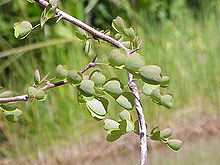
| |
| Scientific classification | |
| Kingdom: | Plantae |
| Clade: | Tracheophytes |
| Clade: | Angiosperms |
| Clade: | Eudicots |
| Clade: | Rosids |
| Order: | Fabales |
| Family: | Fabaceae |
| Subfamily: | Caesalpinioideae |
| Tribe: | Caesalpinieae |
| Genus: | Haematoxylum |
| Species: | H. campechianum
|
| Binomial name | |
| Haematoxylum campechianum L., 1753
| |
| Synonyms | |
| |
Haematoxylum campechianum (blackwood, bloodwood tree, bluewood, campeachy tree, campeachy wood, campeche logwood, campeche wood, Jamaica wood, logwood or logwood tree)[2] is a species of flowering tree in the legume family, Fabaceae, that is native to southern Mexico,where it is known as Árbol de campeche, and introduced to the Caribbean, northern Central America, and other localities around the world.[3] The tree was of great economic importance from the 17th century to the 19th century, when it was commonly logged and exported to Europe for use in dyeing fabrics.[4] The modern nation of Belize developed from 17th- and 18th-century logging camps established by the English. The tree's scientific name means "bloodwood" (haima being Greek for blood and xylon for wood).
https://en.wikipedia.org/wiki/Haematoxylum_campechianum
| Sanguinaria | |
|---|---|
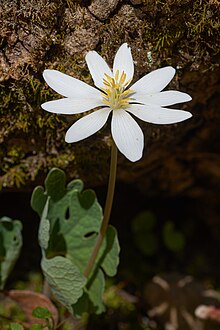
| |
| Scientific classification | |
| Kingdom: | Plantae |
| Clade: | Tracheophytes |
| Clade: | Angiosperms |
| Clade: | Eudicots |
| Order: | Ranunculales |
| Family: | Papaveraceae |
| Subfamily: | Papaveroideae |
| Tribe: | Chelidonieae |
| Genus: | Sanguinaria L. |
| Species: | S. canadensis
|
| Binomial name | |
| Sanguinaria canadensis L.
| |
Sanguinaria canadensis, bloodroot,[1] is a perennial, herbaceous flowering plant native to eastern North America.[2] It is the only species in the genus Sanguinaria, included in the poppy family Papaveraceae, and is most closely related to Eomecon of eastern Asia.
Sanguinaria canadensis is sometimes known as Canada puccoon,[3] bloodwort, redroot, red puccoon, and black paste.[2] Plants are variable in leaf and flower shape, and have been separated as a different subspecies due to these variable shapes, indicating a highly variable species.
In bloodroot, the juice is red and poisonous.[2][4] Products made from sanguinaria extracts, such as black salve, are escharotic and can cause permanent disfiguring scarring.[2] If applied to the skin, the extract sanguinarine may cause a massive scab of dead flesh where it killed the cells, called an eschar.
Although there are laboratory studies indicating that sanguinaria may have potential in cancer therapy, clinical studies are lacking, and its use is discouraged due to significant toxicity.[2]
https://en.wikipedia.org/wiki/Sanguinaria
| Eastern black walnut | |
|---|---|

| |
| Leaves and fruit | |
| Scientific classification | |
| Kingdom: | Plantae |
| Clade: | Tracheophytes |
| Clade: | Angiosperms |
| Clade: | Eudicots |
| Clade: | Rosids |
| Order: | Fagales |
| Family: | Juglandaceae |
| Genus: | Juglans |
| Section: | Juglans sect. Rhysocaryon |
| Species: | J. nigra
|
| Binomial name | |
| Juglans nigra | |
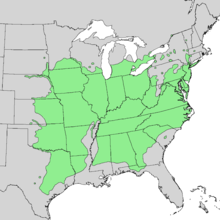
| |
| Natural range | |
Juglans nigra, the eastern American black walnut, is a species of deciduous tree in the walnut family, Juglandaceae, native to North America. It grows mostly in riparian zones, from southern Ontario, west to southeast South Dakota, south to Georgia, northern Florida and southwest to central Texas. Wild trees in the upper Ottawa Valley may be an isolated native population or may have derived from planted trees.
Black walnut is an important tree commercially, as the wood is a deep brown color and easily worked. Walnut seeds (nuts) are cultivated for their distinctive and desirable taste. Walnut trees are grown both for lumber and food, and many cultivars have been developed for improved quality wood or nuts. Black walnut is susceptible to thousand cankers disease, which provoked a decline of walnut trees in some regions.
Black walnut is anecdotally known for being allelopathic, which means that it releases chemicals from its roots and other tissues that may harm other organisms and give the tree a competitive advantage. There is not, however, solid scientific consensus that allelopathic chemicals in black walnut are the primary source of its competitive growth in an area.[2]
https://en.wikipedia.org/wiki/Juglans_nigra
| Reseda | |
|---|---|
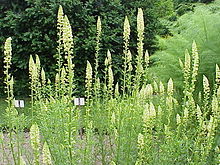
| |
| Reseda lutea (wild mignonette) | |
| Scientific classification | |
| Kingdom: | Plantae |
| Clade: | Tracheophytes |
| Clade: | Angiosperms |
| Clade: | Eudicots |
| Clade: | Rosids |
| Order: | Brassicales |
| Family: | Resedaceae |
| Genus: | Reseda L. |
| Species | |
|
See text | |
Reseda /rɪˈsiːdə/,[1] also known as the mignonette /ˌmɪnjəˈnɛt/,[2] is a genus of fragrant herbaceous plants native to Europe, southwest Asia and North Africa, from the Canary Islands and Iberia east to northwest India. The genus includes herbaceous annual, biennial and perennial species 40–130 cm tall. The leaves form a basal rosette at ground level, and then spirally arranged up the stem; they can be entire, toothed or pinnate, and range from 1–15 cm long. The flowers are produced in a slender spike, each flower small (4–6 mm diameter), white, yellow, orange, or green, with four to six petals. The fruit is a small dry capsule containing several seeds.
Other common names include weld or dyer's rocket (for R. luteola), and bastard rocket.
https://en.wikipedia.org/wiki/Reseda_(plant)


Saffron (/ˈsæfrən, -rɒn/)[1] is a spice derived from the flower of Crocus sativus, commonly known as the "saffron crocus". The vivid crimson stigma and styles, called threads, are collected and dried for use mainly as a seasoning and colouring agent in food. Although some doubts remain on its origin,[2] it is believed that saffron originated in Iran.[3] However, Greece[2] and Mesopotamia[3] have also been suggested as the possible region of origin of this plant. Saffron crocus slowly propagated throughout much of Eurasia and was later brought to parts of North Africa, North America, and Oceania.
Saffron's taste and iodoform-like or hay-like fragrance result from the phytochemicals picrocrocin and safranal.[4][5] It also contains a carotenoid pigment, crocin, which imparts a rich golden-yellow hue to dishes and textiles. Its recorded history is attested in a 7th-century BC Assyrian botanical treatise,[6] and it has been traded and used for thousands of years. In the 21st century, Iran produces some 90% of the world total for saffron.[7][8] At US$5,000 per kg or higher, saffron has long been the world's costliest spice by weight.[9][10][11]
https://en.wikipedia.org/wiki/Saffron
| Turmeric | |
|---|---|

| |
| Inflorescence of Curcuma longa | |

| |
| Turmeric rhizome and powder | |
| Scientific classification | |
| Kingdom: | Plantae |
| Clade: | Tracheophytes |
| Clade: | Angiosperms |
| Clade: | Monocots |
| Clade: | Commelinids |
| Order: | Zingiberales |
| Family: | Zingiberaceae |
| Genus: | Curcuma |
| Species: | C. longa
|
| Binomial name | |
| Curcuma longa | |
| Synonyms | |
|
Curcuma domestica Valeton | |
Turmeric (/ˈtɜːrmərɪk, ˈtjuː-/)[2][3] or Curcuma longa (/ˈkɜːrkjʊmə ˈlɒŋɡə/),[4][5] is a flowering plant in the ginger family Zingiberaceae. It is a perennial, rhizomatous, herbaceous plant native to the Indian subcontinent and Southeast Asia that requires temperatures between 20 and 30 °C (68 and 86 °F) and high annual rainfall to thrive. Plants are gathered each year for their rhizomes, some for propagation in the following season and some for consumption.
The rhizomes are used fresh or boiled in water and dried, after which they are ground into a deep orange-yellow powder commonly used as a coloring and flavoring agent in many Asian cuisines, especially for curries, as well as for the dyeing characteristics imparted by the principal turmeric constituent, curcumin.[6]
Turmeric powder has a warm, bitter, black pepper-like flavor and earthy, mustard-like aroma.[7][8]
Curcumin, a bright yellow chemical produced by the turmeric plant, is approved as a food additive by the World Health Organization, European Parliament, and United States Food and Drug Administration.[6]
Although long used in Ayurvedic medicine, where it is also known as haridra,[9] there is no high-quality clinical evidence that consuming turmeric or curcumin is effective for treating any disease.[10][11]
https://en.wikipedia.org/wiki/Turmeric#Dye




No comments:
Post a Comment